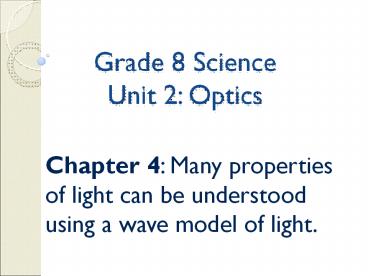Grade 8 Science Unit 2: Optics - PowerPoint PPT Presentation
1 / 45
Title:
Grade 8 Science Unit 2: Optics
Description:
Grade 8 Science Unit 2: Optics Chapter 4: Many properties of light can be understood using a wave model of light. How a Microwave Works Microwave ovens use a specific ... – PowerPoint PPT presentation
Number of Views:306
Avg rating:3.0/5.0
Title: Grade 8 Science Unit 2: Optics
1
Grade 8 ScienceUnit 2 Optics
- Chapter 4 Many properties of light can be
understood using a wave model of light.
2
Lasers
3
The History of Light
- Pythagoras
- A Greek philosopher
- Believed that beams of light were made of tiny
particles. - The eyes detected these particles and could see
the object.
4
- Albert Michelson
- First person to measure the speed of light (3 x
10 m/s)
8
5
Speed Light vs. Sound
- Light
- (Approximate speeds) Actual
Speed - We use Approx speeds
- 1 000 000 000 km/h 1,080, 000, 000 km/h
- 300 000 000 m/s 299 792 458 m / s
- 300 000 km/s 299,792.458 Km/s
- Sound
- 1 200 km/h
6
Thunder Lightning
7
- Both the lightning strike and the roar of thunder
happen at the same time. - You see the lightning first.
- If you multiply the time in seconds between the
strike and the roar by the speed of sound, you
will find the approximate distance.
8
Orion's Belt
The light takes thousands of years to reach our
eyes
9
Light Technologies Include...
- Microscope
- Telescope
- Periscope
- Binoculars
- Fibre optics
- Camera
10
- Prescription contact lenses
- Laser
- Movie projectors
- Overhead projectors
11
Light
- Light a form of energy that can be detected by
the human eye. - Visible light a mixture of all the colors of the
rainbow.
12
Rainbow
13
Properties of Visible Light...
- 1. Light travels in a straight line. (rectilinear
propagation)
14
- 2. Light reflects (reflection)
Mirror
Dust
15
- 3. Light refracts (Refraction)
The Bent Stick Effect
16
- 4. Light Disperses (dispersion)
Light separates into its constituent colors.
17
- 5. Light travels through a vacuum (does not
require a medium no particles involved)
18
- 6. Travels through objects to different degrees
19
Visible Light Spectrum
- Can be seen due to the dispersion of light
through a prism.
20
- The constituent colors of white light are
- Red
- Orange
- Yellow
- Green
- Blue
- Indigo
- Violet
ROY G BIV
Red has the smallest refraction and violet has
the greatest.
21
When a laser is shone through a prism, the light
will refract but disperse. Why? A laser light
is one color only!
22
The Wave Model
- Explains that light is a type of wave that
travels through empty space and transfers energy
from one place to another
23
A Wave...
A Peak is also called the crest.
24
- Frequency the number of repetitive motions that
occur during a given time. - Ex. The number of wavelengths that pass a point
in 1 second. - Measured in Hertz
25
- Amplitude the height of a wave crest or depth of
a wave trough as measured from the rest position. - crest height trough depth
- The larger the amplitude, the greater the energy
transported.
26
- Wavelength the distance from crest to crest,
trough to trough or the distance covered by one
complete crest and one complete trough. - Measured in meters
- Longer wavelengths refract the least.
27
Frequency and Wavelength
- High frequency waves have short wavelengths
- Low frequency waves have short wavelengths
28
Wavelength - Frequency Relationship
29
Electromagnetic Radiation
- The transmission of energy in the form of waves
that extend from the longest radio waves to the
shortest gamma rays.
30
Electromagnetic Radiation
31
Types of Electromagnetic Radiation
- 1. Radio waves the longest wavelength and lowest
energy and frequency. - Can be used to help us see the inside of our
bodies to diagnose illness. Ex. MRI
32
Magnetic Resonance Imaging
33
- 2. Microwaves have the shortest wavelength and
the highest frequency of all radio waves. - Ex. Microwave ovens, telecommunication
satellites, radio telescopes, radar (remote
sensing)
34
How a Microwave Works
Microwave ovens use a specific frequency that is
strongly absorbed by water molecules in food.
35
- 3. Infrared Waves longer wavelength and lower
energy and frequency. - Infrared means below red
- Also called heat radiation
- Ex. Remote controls, computer, heat lamps, motion
sensors
36
LANDSAT Image of Fire
Infrared Radiation
37
- 4. Visible Light Spectrum
- Can be continually detected by our eyes.
38
- 5. Ultraviolet Waves shorter wavelength and
higher energy and frequency. - Very energetic
- Have the ability to kill bacteria in food and
water and medical supplies. - Ex. Sun, detect fingerprints
39
Using Ultraviolet Radiation
40
- 6. X-Rays have a shorter wavelength, and higher
energy and frequency than UV. - Used to photograph teeth, bones and the inside of
machines, security screening
41
X-Ray Imaging
42
- 7. Gamma Rays have the highest energy and
frequency and the shortest wavelength. - Result from nuclear reactions.
- Produced by the hottest regions of the universe.
43
Gamma Rays Nuclear Explosion
Gamma Rays Medical Treatment
44
Electromagnetic Radiation... A Safety Concern?
Generally, higher energy electromagnetic
radiation is more harmful to humans. The Earths
atmosphere is able to protect us from some of the
more dangerous electromagnetic radiation present
in space, making the Earth a safe place for
humans. Changes to present conditions may
comprise our safety.
45
Positive and Negative Effects to Exposure to
Electromagnetic Radiation
X-Rays Ultraviolet Radio Waves
Positive Effects Medical detection Used to treat jaundice in babies Improved tele-communication
Negative Effects Over-exposure can lead to cancer Skin cancer Uncertain of long-term exposure

